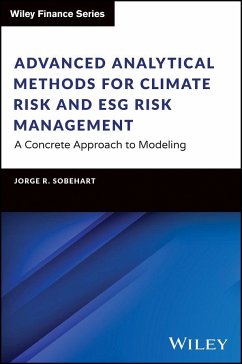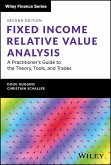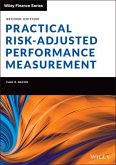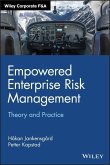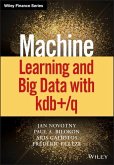Jorge R. Sobehart (Atomic Energy Commission of Argentina (Nuclear F
Advanced Analytical Methods for Climate Risk and Esg Risk Management
A Concrete Approach to Modeling
Jorge R. Sobehart (Atomic Energy Commission of Argentina (Nuclear F
Advanced Analytical Methods for Climate Risk and Esg Risk Management
A Concrete Approach to Modeling
- Gebundenes Buch
- Merkliste
- Auf die Merkliste
- Bewerten Bewerten
- Teilen
- Produkt teilen
- Produkterinnerung
- Produkterinnerung
PRACTICAL, QUANTITATIVE METHODS FOR ASSESSING THE POTENTIAL IMPACT OF CLIMATE RISKS Written by quantitative modelling expert Jorge Sobehart, Advanced Analytical Methods for Climate Risk and ESG Risk Management is an essential guide for risk management professionals tasked with addressing potential losses incurred from the shifting climate of our planet. In reading this book, you will gain a foundation of knowledge in the scientific and practical aspects of climate change, including a historical understanding that will enable you to maintain the perspective needed to soberly quantify risk. You…mehr
Andere Kunden interessierten sich auch für
![Fixed Income Relative Value Analysis + Website Fixed Income Relative Value Analysis + Website]() Doug HugginsFixed Income Relative Value Analysis + Website95,99 €
Doug HugginsFixed Income Relative Value Analysis + Website95,99 €![Practical Risk-Adjusted Performance Measurement Practical Risk-Adjusted Performance Measurement]() Carl R. Bacon (Confluence)Practical Risk-Adjusted Performance Measurement100,99 €
Carl R. Bacon (Confluence)Practical Risk-Adjusted Performance Measurement100,99 €![Measuring Esg Effects in Systematic Investing Measuring Esg Effects in Systematic Investing]() Arik Ben DorMeasuring Esg Effects in Systematic Investing100,99 €
Arik Ben DorMeasuring Esg Effects in Systematic Investing100,99 €![Empowered Enterprise Risk Management Empowered Enterprise Risk Management]() Hakan JankensgardEmpowered Enterprise Risk Management38,99 €
Hakan JankensgardEmpowered Enterprise Risk Management38,99 €![Machine Learning and Big Data with Kdb+/Q Machine Learning and Big Data with Kdb+/Q]() Jan NovotnyMachine Learning and Big Data with Kdb+/Q85,99 €
Jan NovotnyMachine Learning and Big Data with Kdb+/Q85,99 €![Advanced Portfolio Management Advanced Portfolio Management]() Giuseppe A. PaleologoAdvanced Portfolio Management35,99 €
Giuseppe A. PaleologoAdvanced Portfolio Management35,99 €![The Essentials of Financial Modeling in Excel The Essentials of Financial Modeling in Excel]() Michael Rees (Audencia Business School)The Essentials of Financial Modeling in Excel48,99 €
Michael Rees (Audencia Business School)The Essentials of Financial Modeling in Excel48,99 €-
-
PRACTICAL, QUANTITATIVE METHODS FOR ASSESSING THE POTENTIAL IMPACT OF CLIMATE RISKS Written by quantitative modelling expert Jorge Sobehart, Advanced Analytical Methods for Climate Risk and ESG Risk Management is an essential guide for risk management professionals tasked with addressing potential losses incurred from the shifting climate of our planet. In reading this book, you will gain a foundation of knowledge in the scientific and practical aspects of climate change, including a historical understanding that will enable you to maintain the perspective needed to soberly quantify risk. You will also find a strong framework for stress testing portfolios, estimating potential losses and reserve requirements. By employing information systems to aid in the monitoring and managing of climate risk, you can gather the data that will enable you to methodically apply risk allocation and management strategies--described in detail inside. With Advanced Analytical Methods for Climate Risk and ESG Risk Management, you will gain insight into the potential impact of climate change across businesses of all sizes, across industries, and across the globe. These analytical methods for risk management will lead to improved understanding of the choices and obligations present in today's financial markets.
Hinweis: Dieser Artikel kann nur an eine deutsche Lieferadresse ausgeliefert werden.
Hinweis: Dieser Artikel kann nur an eine deutsche Lieferadresse ausgeliefert werden.
Produktdetails
- Produktdetails
- The Wiley Finance Series
- Verlag: John Wiley & Sons Inc
- Seitenzahl: 496
- Erscheinungstermin: 19. August 2024
- Englisch
- Abmessung: 235mm x 161mm x 30mm
- Gewicht: 858g
- ISBN-13: 9781394220090
- ISBN-10: 139422009X
- Artikelnr.: 70199899
- Herstellerkennzeichnung
- Libri GmbH
- Europaallee 1
- 36244 Bad Hersfeld
- gpsr@libri.de
- The Wiley Finance Series
- Verlag: John Wiley & Sons Inc
- Seitenzahl: 496
- Erscheinungstermin: 19. August 2024
- Englisch
- Abmessung: 235mm x 161mm x 30mm
- Gewicht: 858g
- ISBN-13: 9781394220090
- ISBN-10: 139422009X
- Artikelnr.: 70199899
- Herstellerkennzeichnung
- Libri GmbH
- Europaallee 1
- 36244 Bad Hersfeld
- gpsr@libri.de
JORGE SOBEHART has over 35 years of experience in advanced quantitative modelling in industry and government, having worked for prestigious institutions including the Atomic Energy Commission of Argentina (Nuclear Fusion Division), the Center for Nonlinear Studies at the US Los Alamos National Laboratory, Moody's Investors Service, and CASA, a cutting-edge financial consulting start-up, making contributions in the fields of risk management, behavioral finance, theoretical and applied physics, computation and mathematical modeling. He also acted as a technical reviewer for several book editors and over a dozen professional journals in these fields. He is currently a Managing Director at a large global financial institution, leading analytics for wholesale credit and climate risk and risk ratings. During his career, he designed and developed frameworks for wholesale credit risk capital and allocation, credit and climate risk stress testing (CCAR, ICAAP, Climate Risk), credit reserves (CECL, IFRS9, FAS5), risk ratings, probability of default and various early warning tools of credit deterioration.
Introduction: Climate Risk and Environmental, Social and Governance
Challenges xiii
Chapter 1 Introduction to Climate Risk 1
Dimensions of Climate Risk 1
Basic Concepts of Climate 2
Carbon Dioxide, Greenhouse Gases (GHG), and Air Pollution 5
The Science of Climate Change 6
Climate Change, the Intergovernmental Panel on Climate Change (IPCC)
Reports, and Social Change 10
References 12
Chapter 2 Forces of Nature 15
The Astronomical Theory of Climate Change 15
The Sun 24
The Earth 27
Air and Wind 30
Water and Ice 32
The Carbon Cycle 34
Note 36
References 36
Chapter 3 A Brief History of Climate Change 39
Natural Drivers of Climate Change Over the Ages 39
Frozen Earth 40
Warming and Freezing Cycles and Periodic Glaciations 41
The Last Ice Age, Younger Dryas, and Climate Cycles 42
Climate Change in Ancient Times 43
Roman Warm Period 44
The Climate in the Dark Ages 44
The Medieval Warm Period 45
The Little Ice Age 46
The Industrial Revolution and Man-Made Effects 48
Today and Tomorrow 52
References 52
Chapter 4 Science, Politics, and Public Policy 55
Science, Facts, Perception, Social Influence, Misinformation, and Fear 55
Behavioral Aspects of Risk Taking and Decision Making 56
Perception and Plausibility of Events 59
Trust, Deception, Credibility, and Fake News 60
Social Pressure, Conformity, and Media Bias 63
Social Polarization 65
Opinion Polarization under Social Pressure and Media Bias 67
Social Pressure, Media Bias, and Perception for Different Groups 70
Choice Impact for Different Groups 74
What's Next? Tackling the Climate Change Challenge 76
References 78
Chapter 5 Global Shift in Response to Climate Change 81
The Shift in the Global Economy in Response to Climate Change 81
Technology Change: First Movers, Competitive Landscape, and Economic
Environments 87
Climate Risk Uncertainty in Competitive Business Environments 90
Innovation and Product Dynamics 93
Product Adoption 95
Product Competition 98
Multiple Competitor Environments 100
Uncertainty in Competitive Environments 103
Notes 107
References 107
Chapter 6 Risk Management for Climate Risk and ESG 111
Overview, Purpose, Scope of Risk Management, and Governance 111
Risk Identification, Measurement, and Management 113
Regulatory Environment and Climate Risk 126
Operational Readiness and Resilience for Climate-Related Effects 128
Risk Monitoring and Reporting 132
Risk Reporting and Analysis 133
Reshaping the Industry Landscape: Winners, Losers, and Synergies 135
Sustainability, Competitive Environment, and a Level Playing Field 138
Climate-Related Financial Disclosures 138
Climate Risk Financial Disclosures 143
Building a Stress-Testing Framework for Climate Risk Using ThreeCorePillars
155
References 161
Chapter 7 Pillar 1: Competitive Landscape and Climate Risk Scenarios for
Stress Testing 163
Assessing the Industry and Regulatory Landscape, Synergies, and
Complexities of Competitive Business Environments 163
Scenarios for the Global Economy: Economic, Business, and Credit Cycles 164
Business Cycles, Credit Supply, and Demand 171
Economic Drivers 173
Economic Activity and Credit Demand 174
The Impact of Local Economic Conditions on Global Obligors 206
References 208
Chapter 8 Pillar 2: Demand for Credit: Modeling Default Risk and Loss
Severity 211
Supply and Demand for Credit: Excess Credit Demand 211
Analysis of Economic Activity 216
Defining Key Concepts: Default, Loss Likelihood, and Loss Severity 217
Credit Correlation 232
Note 239
References 239
Chapter 9 Pillar 2: Demand for Credit: Risk Assessment and Credit Risk
Ratings 245
The Path to Business Failure 245
Risk Assessment and Credit Risk Ratings 246
Credit Risk Ratings 248
Default and Loss Concepts and Risk Ratings 259
Default Rate Statistics by Rating Category 261
Rating Transition Matrices 264
Rating Transitions and the Term Structure of Default Rates 265
Portfolio Risk Rating 267
Portfolio Trend Rating 267
Risk Management Rating 267
Rating Stability 270
Quantifying Analysts' Perception of Credit Risk: A Behavioral Model 271
Notes 295
References 295
Chapter 10 Pillar 2: Demand for Credit: The Value of Financial Information
297
The Value of Financial Information: Balance Sheet, Income Statement, and
Statement of Cash Flows 297
The Balance Sheet 298
The Income Statement 305
The Statement of Cash Flows 309
Financial Information and Uncertainty 313
Cash Liquidity and Debt Capacity 314
Cash Shortfall, Business Uncertainty, and Financial Distress 317
Note 321
References 321
Chapter 11 Pillar 2: Demand for Credit: Models of Business Failure 325
Credit Risk Models of Business Failure 325
Model Selection 329
Statistical and Econometric Models 330
Credit Scoring and Statistical Discriminant Analysis 333
Models of Probability of Default 340
Nonlinear Models 343
Statistical Inference and Bayesian Methods 345
Model Selection Criteria: Least Squares and Likelihood Methods 347
Information Entropy Methods and Model Selection 348
A Primer on Neural Networks 356
Validating Statistical Models 361
Measuring Model Accuracy 361
A Validation Approach for Quantitative Models 363
Resampling 368
Model Performance and Benchmarking 368
References 380
Chapter 12 Pillar 2: Structural Models 383
The Role of Market Information in the Pricing of Risky Debt 383
Options Pricing, Randomness, and the Notion of Limit 386
Options Pricing and Stochastic Calculus 386
Ito Stochastic Integrals, Convergence, and the Notion of Limit 389
Hedging Portfolio Returns in the Limit vs. Hedging the Limit of Portfolio
Changes 391
Residual Risk and Volatility Skews 394
Hedging Strategies and Residual Risk 395
Models and Assumptions 397
Asset-Based Models and Market Uncertainty 398
Forward-Looking, Singular Perturbation Analysis 400
Market Uncertainty and the Valuation of Equity and Debt 408
Revisiting the Default Point 412
The Role of the Company's Borrowing Capacity 413
Joint Distribution of Assets, Equity, and Debt 415
Uncertainty, Arbitrage, and Equity-Debt Relationship 421
Notes 424
References 424
Chapter 13 Pillar 3: Supply of Credit: Modeling Lender's Behavior and
Business Strategies 429
Portfolio Management 429
Estimating Portfolio Losses 434
References 448
Acknowledgments 451
About the Author 453
Index 455
Challenges xiii
Chapter 1 Introduction to Climate Risk 1
Dimensions of Climate Risk 1
Basic Concepts of Climate 2
Carbon Dioxide, Greenhouse Gases (GHG), and Air Pollution 5
The Science of Climate Change 6
Climate Change, the Intergovernmental Panel on Climate Change (IPCC)
Reports, and Social Change 10
References 12
Chapter 2 Forces of Nature 15
The Astronomical Theory of Climate Change 15
The Sun 24
The Earth 27
Air and Wind 30
Water and Ice 32
The Carbon Cycle 34
Note 36
References 36
Chapter 3 A Brief History of Climate Change 39
Natural Drivers of Climate Change Over the Ages 39
Frozen Earth 40
Warming and Freezing Cycles and Periodic Glaciations 41
The Last Ice Age, Younger Dryas, and Climate Cycles 42
Climate Change in Ancient Times 43
Roman Warm Period 44
The Climate in the Dark Ages 44
The Medieval Warm Period 45
The Little Ice Age 46
The Industrial Revolution and Man-Made Effects 48
Today and Tomorrow 52
References 52
Chapter 4 Science, Politics, and Public Policy 55
Science, Facts, Perception, Social Influence, Misinformation, and Fear 55
Behavioral Aspects of Risk Taking and Decision Making 56
Perception and Plausibility of Events 59
Trust, Deception, Credibility, and Fake News 60
Social Pressure, Conformity, and Media Bias 63
Social Polarization 65
Opinion Polarization under Social Pressure and Media Bias 67
Social Pressure, Media Bias, and Perception for Different Groups 70
Choice Impact for Different Groups 74
What's Next? Tackling the Climate Change Challenge 76
References 78
Chapter 5 Global Shift in Response to Climate Change 81
The Shift in the Global Economy in Response to Climate Change 81
Technology Change: First Movers, Competitive Landscape, and Economic
Environments 87
Climate Risk Uncertainty in Competitive Business Environments 90
Innovation and Product Dynamics 93
Product Adoption 95
Product Competition 98
Multiple Competitor Environments 100
Uncertainty in Competitive Environments 103
Notes 107
References 107
Chapter 6 Risk Management for Climate Risk and ESG 111
Overview, Purpose, Scope of Risk Management, and Governance 111
Risk Identification, Measurement, and Management 113
Regulatory Environment and Climate Risk 126
Operational Readiness and Resilience for Climate-Related Effects 128
Risk Monitoring and Reporting 132
Risk Reporting and Analysis 133
Reshaping the Industry Landscape: Winners, Losers, and Synergies 135
Sustainability, Competitive Environment, and a Level Playing Field 138
Climate-Related Financial Disclosures 138
Climate Risk Financial Disclosures 143
Building a Stress-Testing Framework for Climate Risk Using ThreeCorePillars
155
References 161
Chapter 7 Pillar 1: Competitive Landscape and Climate Risk Scenarios for
Stress Testing 163
Assessing the Industry and Regulatory Landscape, Synergies, and
Complexities of Competitive Business Environments 163
Scenarios for the Global Economy: Economic, Business, and Credit Cycles 164
Business Cycles, Credit Supply, and Demand 171
Economic Drivers 173
Economic Activity and Credit Demand 174
The Impact of Local Economic Conditions on Global Obligors 206
References 208
Chapter 8 Pillar 2: Demand for Credit: Modeling Default Risk and Loss
Severity 211
Supply and Demand for Credit: Excess Credit Demand 211
Analysis of Economic Activity 216
Defining Key Concepts: Default, Loss Likelihood, and Loss Severity 217
Credit Correlation 232
Note 239
References 239
Chapter 9 Pillar 2: Demand for Credit: Risk Assessment and Credit Risk
Ratings 245
The Path to Business Failure 245
Risk Assessment and Credit Risk Ratings 246
Credit Risk Ratings 248
Default and Loss Concepts and Risk Ratings 259
Default Rate Statistics by Rating Category 261
Rating Transition Matrices 264
Rating Transitions and the Term Structure of Default Rates 265
Portfolio Risk Rating 267
Portfolio Trend Rating 267
Risk Management Rating 267
Rating Stability 270
Quantifying Analysts' Perception of Credit Risk: A Behavioral Model 271
Notes 295
References 295
Chapter 10 Pillar 2: Demand for Credit: The Value of Financial Information
297
The Value of Financial Information: Balance Sheet, Income Statement, and
Statement of Cash Flows 297
The Balance Sheet 298
The Income Statement 305
The Statement of Cash Flows 309
Financial Information and Uncertainty 313
Cash Liquidity and Debt Capacity 314
Cash Shortfall, Business Uncertainty, and Financial Distress 317
Note 321
References 321
Chapter 11 Pillar 2: Demand for Credit: Models of Business Failure 325
Credit Risk Models of Business Failure 325
Model Selection 329
Statistical and Econometric Models 330
Credit Scoring and Statistical Discriminant Analysis 333
Models of Probability of Default 340
Nonlinear Models 343
Statistical Inference and Bayesian Methods 345
Model Selection Criteria: Least Squares and Likelihood Methods 347
Information Entropy Methods and Model Selection 348
A Primer on Neural Networks 356
Validating Statistical Models 361
Measuring Model Accuracy 361
A Validation Approach for Quantitative Models 363
Resampling 368
Model Performance and Benchmarking 368
References 380
Chapter 12 Pillar 2: Structural Models 383
The Role of Market Information in the Pricing of Risky Debt 383
Options Pricing, Randomness, and the Notion of Limit 386
Options Pricing and Stochastic Calculus 386
Ito Stochastic Integrals, Convergence, and the Notion of Limit 389
Hedging Portfolio Returns in the Limit vs. Hedging the Limit of Portfolio
Changes 391
Residual Risk and Volatility Skews 394
Hedging Strategies and Residual Risk 395
Models and Assumptions 397
Asset-Based Models and Market Uncertainty 398
Forward-Looking, Singular Perturbation Analysis 400
Market Uncertainty and the Valuation of Equity and Debt 408
Revisiting the Default Point 412
The Role of the Company's Borrowing Capacity 413
Joint Distribution of Assets, Equity, and Debt 415
Uncertainty, Arbitrage, and Equity-Debt Relationship 421
Notes 424
References 424
Chapter 13 Pillar 3: Supply of Credit: Modeling Lender's Behavior and
Business Strategies 429
Portfolio Management 429
Estimating Portfolio Losses 434
References 448
Acknowledgments 451
About the Author 453
Index 455
Introduction: Climate Risk and Environmental, Social and Governance
Challenges xiii
Chapter 1 Introduction to Climate Risk 1
Dimensions of Climate Risk 1
Basic Concepts of Climate 2
Carbon Dioxide, Greenhouse Gases (GHG), and Air Pollution 5
The Science of Climate Change 6
Climate Change, the Intergovernmental Panel on Climate Change (IPCC)
Reports, and Social Change 10
References 12
Chapter 2 Forces of Nature 15
The Astronomical Theory of Climate Change 15
The Sun 24
The Earth 27
Air and Wind 30
Water and Ice 32
The Carbon Cycle 34
Note 36
References 36
Chapter 3 A Brief History of Climate Change 39
Natural Drivers of Climate Change Over the Ages 39
Frozen Earth 40
Warming and Freezing Cycles and Periodic Glaciations 41
The Last Ice Age, Younger Dryas, and Climate Cycles 42
Climate Change in Ancient Times 43
Roman Warm Period 44
The Climate in the Dark Ages 44
The Medieval Warm Period 45
The Little Ice Age 46
The Industrial Revolution and Man-Made Effects 48
Today and Tomorrow 52
References 52
Chapter 4 Science, Politics, and Public Policy 55
Science, Facts, Perception, Social Influence, Misinformation, and Fear 55
Behavioral Aspects of Risk Taking and Decision Making 56
Perception and Plausibility of Events 59
Trust, Deception, Credibility, and Fake News 60
Social Pressure, Conformity, and Media Bias 63
Social Polarization 65
Opinion Polarization under Social Pressure and Media Bias 67
Social Pressure, Media Bias, and Perception for Different Groups 70
Choice Impact for Different Groups 74
What's Next? Tackling the Climate Change Challenge 76
References 78
Chapter 5 Global Shift in Response to Climate Change 81
The Shift in the Global Economy in Response to Climate Change 81
Technology Change: First Movers, Competitive Landscape, and Economic
Environments 87
Climate Risk Uncertainty in Competitive Business Environments 90
Innovation and Product Dynamics 93
Product Adoption 95
Product Competition 98
Multiple Competitor Environments 100
Uncertainty in Competitive Environments 103
Notes 107
References 107
Chapter 6 Risk Management for Climate Risk and ESG 111
Overview, Purpose, Scope of Risk Management, and Governance 111
Risk Identification, Measurement, and Management 113
Regulatory Environment and Climate Risk 126
Operational Readiness and Resilience for Climate-Related Effects 128
Risk Monitoring and Reporting 132
Risk Reporting and Analysis 133
Reshaping the Industry Landscape: Winners, Losers, and Synergies 135
Sustainability, Competitive Environment, and a Level Playing Field 138
Climate-Related Financial Disclosures 138
Climate Risk Financial Disclosures 143
Building a Stress-Testing Framework for Climate Risk Using ThreeCorePillars
155
References 161
Chapter 7 Pillar 1: Competitive Landscape and Climate Risk Scenarios for
Stress Testing 163
Assessing the Industry and Regulatory Landscape, Synergies, and
Complexities of Competitive Business Environments 163
Scenarios for the Global Economy: Economic, Business, and Credit Cycles 164
Business Cycles, Credit Supply, and Demand 171
Economic Drivers 173
Economic Activity and Credit Demand 174
The Impact of Local Economic Conditions on Global Obligors 206
References 208
Chapter 8 Pillar 2: Demand for Credit: Modeling Default Risk and Loss
Severity 211
Supply and Demand for Credit: Excess Credit Demand 211
Analysis of Economic Activity 216
Defining Key Concepts: Default, Loss Likelihood, and Loss Severity 217
Credit Correlation 232
Note 239
References 239
Chapter 9 Pillar 2: Demand for Credit: Risk Assessment and Credit Risk
Ratings 245
The Path to Business Failure 245
Risk Assessment and Credit Risk Ratings 246
Credit Risk Ratings 248
Default and Loss Concepts and Risk Ratings 259
Default Rate Statistics by Rating Category 261
Rating Transition Matrices 264
Rating Transitions and the Term Structure of Default Rates 265
Portfolio Risk Rating 267
Portfolio Trend Rating 267
Risk Management Rating 267
Rating Stability 270
Quantifying Analysts' Perception of Credit Risk: A Behavioral Model 271
Notes 295
References 295
Chapter 10 Pillar 2: Demand for Credit: The Value of Financial Information
297
The Value of Financial Information: Balance Sheet, Income Statement, and
Statement of Cash Flows 297
The Balance Sheet 298
The Income Statement 305
The Statement of Cash Flows 309
Financial Information and Uncertainty 313
Cash Liquidity and Debt Capacity 314
Cash Shortfall, Business Uncertainty, and Financial Distress 317
Note 321
References 321
Chapter 11 Pillar 2: Demand for Credit: Models of Business Failure 325
Credit Risk Models of Business Failure 325
Model Selection 329
Statistical and Econometric Models 330
Credit Scoring and Statistical Discriminant Analysis 333
Models of Probability of Default 340
Nonlinear Models 343
Statistical Inference and Bayesian Methods 345
Model Selection Criteria: Least Squares and Likelihood Methods 347
Information Entropy Methods and Model Selection 348
A Primer on Neural Networks 356
Validating Statistical Models 361
Measuring Model Accuracy 361
A Validation Approach for Quantitative Models 363
Resampling 368
Model Performance and Benchmarking 368
References 380
Chapter 12 Pillar 2: Structural Models 383
The Role of Market Information in the Pricing of Risky Debt 383
Options Pricing, Randomness, and the Notion of Limit 386
Options Pricing and Stochastic Calculus 386
Ito Stochastic Integrals, Convergence, and the Notion of Limit 389
Hedging Portfolio Returns in the Limit vs. Hedging the Limit of Portfolio
Changes 391
Residual Risk and Volatility Skews 394
Hedging Strategies and Residual Risk 395
Models and Assumptions 397
Asset-Based Models and Market Uncertainty 398
Forward-Looking, Singular Perturbation Analysis 400
Market Uncertainty and the Valuation of Equity and Debt 408
Revisiting the Default Point 412
The Role of the Company's Borrowing Capacity 413
Joint Distribution of Assets, Equity, and Debt 415
Uncertainty, Arbitrage, and Equity-Debt Relationship 421
Notes 424
References 424
Chapter 13 Pillar 3: Supply of Credit: Modeling Lender's Behavior and
Business Strategies 429
Portfolio Management 429
Estimating Portfolio Losses 434
References 448
Acknowledgments 451
About the Author 453
Index 455
Challenges xiii
Chapter 1 Introduction to Climate Risk 1
Dimensions of Climate Risk 1
Basic Concepts of Climate 2
Carbon Dioxide, Greenhouse Gases (GHG), and Air Pollution 5
The Science of Climate Change 6
Climate Change, the Intergovernmental Panel on Climate Change (IPCC)
Reports, and Social Change 10
References 12
Chapter 2 Forces of Nature 15
The Astronomical Theory of Climate Change 15
The Sun 24
The Earth 27
Air and Wind 30
Water and Ice 32
The Carbon Cycle 34
Note 36
References 36
Chapter 3 A Brief History of Climate Change 39
Natural Drivers of Climate Change Over the Ages 39
Frozen Earth 40
Warming and Freezing Cycles and Periodic Glaciations 41
The Last Ice Age, Younger Dryas, and Climate Cycles 42
Climate Change in Ancient Times 43
Roman Warm Period 44
The Climate in the Dark Ages 44
The Medieval Warm Period 45
The Little Ice Age 46
The Industrial Revolution and Man-Made Effects 48
Today and Tomorrow 52
References 52
Chapter 4 Science, Politics, and Public Policy 55
Science, Facts, Perception, Social Influence, Misinformation, and Fear 55
Behavioral Aspects of Risk Taking and Decision Making 56
Perception and Plausibility of Events 59
Trust, Deception, Credibility, and Fake News 60
Social Pressure, Conformity, and Media Bias 63
Social Polarization 65
Opinion Polarization under Social Pressure and Media Bias 67
Social Pressure, Media Bias, and Perception for Different Groups 70
Choice Impact for Different Groups 74
What's Next? Tackling the Climate Change Challenge 76
References 78
Chapter 5 Global Shift in Response to Climate Change 81
The Shift in the Global Economy in Response to Climate Change 81
Technology Change: First Movers, Competitive Landscape, and Economic
Environments 87
Climate Risk Uncertainty in Competitive Business Environments 90
Innovation and Product Dynamics 93
Product Adoption 95
Product Competition 98
Multiple Competitor Environments 100
Uncertainty in Competitive Environments 103
Notes 107
References 107
Chapter 6 Risk Management for Climate Risk and ESG 111
Overview, Purpose, Scope of Risk Management, and Governance 111
Risk Identification, Measurement, and Management 113
Regulatory Environment and Climate Risk 126
Operational Readiness and Resilience for Climate-Related Effects 128
Risk Monitoring and Reporting 132
Risk Reporting and Analysis 133
Reshaping the Industry Landscape: Winners, Losers, and Synergies 135
Sustainability, Competitive Environment, and a Level Playing Field 138
Climate-Related Financial Disclosures 138
Climate Risk Financial Disclosures 143
Building a Stress-Testing Framework for Climate Risk Using ThreeCorePillars
155
References 161
Chapter 7 Pillar 1: Competitive Landscape and Climate Risk Scenarios for
Stress Testing 163
Assessing the Industry and Regulatory Landscape, Synergies, and
Complexities of Competitive Business Environments 163
Scenarios for the Global Economy: Economic, Business, and Credit Cycles 164
Business Cycles, Credit Supply, and Demand 171
Economic Drivers 173
Economic Activity and Credit Demand 174
The Impact of Local Economic Conditions on Global Obligors 206
References 208
Chapter 8 Pillar 2: Demand for Credit: Modeling Default Risk and Loss
Severity 211
Supply and Demand for Credit: Excess Credit Demand 211
Analysis of Economic Activity 216
Defining Key Concepts: Default, Loss Likelihood, and Loss Severity 217
Credit Correlation 232
Note 239
References 239
Chapter 9 Pillar 2: Demand for Credit: Risk Assessment and Credit Risk
Ratings 245
The Path to Business Failure 245
Risk Assessment and Credit Risk Ratings 246
Credit Risk Ratings 248
Default and Loss Concepts and Risk Ratings 259
Default Rate Statistics by Rating Category 261
Rating Transition Matrices 264
Rating Transitions and the Term Structure of Default Rates 265
Portfolio Risk Rating 267
Portfolio Trend Rating 267
Risk Management Rating 267
Rating Stability 270
Quantifying Analysts' Perception of Credit Risk: A Behavioral Model 271
Notes 295
References 295
Chapter 10 Pillar 2: Demand for Credit: The Value of Financial Information
297
The Value of Financial Information: Balance Sheet, Income Statement, and
Statement of Cash Flows 297
The Balance Sheet 298
The Income Statement 305
The Statement of Cash Flows 309
Financial Information and Uncertainty 313
Cash Liquidity and Debt Capacity 314
Cash Shortfall, Business Uncertainty, and Financial Distress 317
Note 321
References 321
Chapter 11 Pillar 2: Demand for Credit: Models of Business Failure 325
Credit Risk Models of Business Failure 325
Model Selection 329
Statistical and Econometric Models 330
Credit Scoring and Statistical Discriminant Analysis 333
Models of Probability of Default 340
Nonlinear Models 343
Statistical Inference and Bayesian Methods 345
Model Selection Criteria: Least Squares and Likelihood Methods 347
Information Entropy Methods and Model Selection 348
A Primer on Neural Networks 356
Validating Statistical Models 361
Measuring Model Accuracy 361
A Validation Approach for Quantitative Models 363
Resampling 368
Model Performance and Benchmarking 368
References 380
Chapter 12 Pillar 2: Structural Models 383
The Role of Market Information in the Pricing of Risky Debt 383
Options Pricing, Randomness, and the Notion of Limit 386
Options Pricing and Stochastic Calculus 386
Ito Stochastic Integrals, Convergence, and the Notion of Limit 389
Hedging Portfolio Returns in the Limit vs. Hedging the Limit of Portfolio
Changes 391
Residual Risk and Volatility Skews 394
Hedging Strategies and Residual Risk 395
Models and Assumptions 397
Asset-Based Models and Market Uncertainty 398
Forward-Looking, Singular Perturbation Analysis 400
Market Uncertainty and the Valuation of Equity and Debt 408
Revisiting the Default Point 412
The Role of the Company's Borrowing Capacity 413
Joint Distribution of Assets, Equity, and Debt 415
Uncertainty, Arbitrage, and Equity-Debt Relationship 421
Notes 424
References 424
Chapter 13 Pillar 3: Supply of Credit: Modeling Lender's Behavior and
Business Strategies 429
Portfolio Management 429
Estimating Portfolio Losses 434
References 448
Acknowledgments 451
About the Author 453
Index 455

